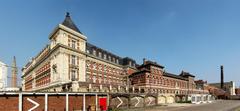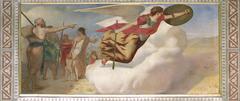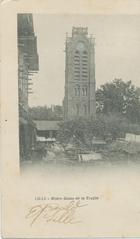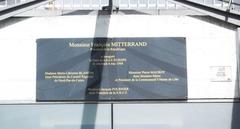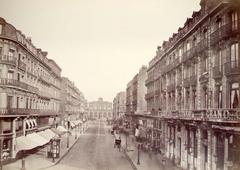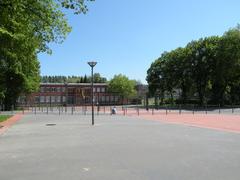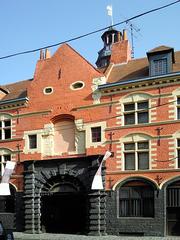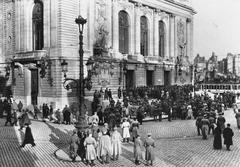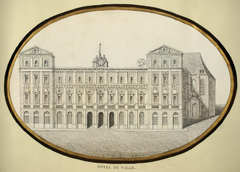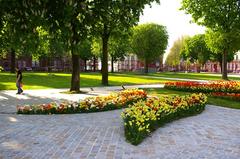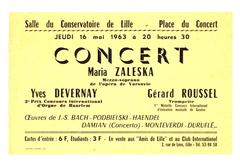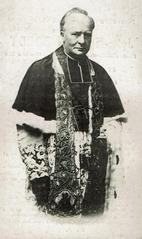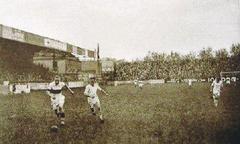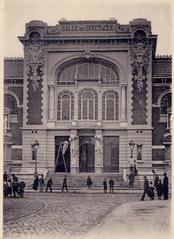39 Rue de la Monnaie, Lille: Visiting Hours, Tickets, and Historical Sites Guide
Date: 03/07/2025
Introduction
Nestled in the heart of Vieux-Lille, 39 Rue de la Monnaie stands as one of Lille’s most iconic and historically significant addresses. This 16th-century, timber-framed house is the last of its kind in the city, serving as a rare testament to Lille’s medieval and Renaissance heritage. The street itself, once central to the city’s coin minting industry under Louis XIV, is a living chronicle of Lille’s economic, architectural, and administrative evolution. Today, 39 Rue de la Monnaie not only preserves this rich history but also functions as a vibrant diocesan center, blending historical preservation with community life. This comprehensive guide covers visiting hours, ticketing, accessibility, nearby attractions, and tips for making the most of your visit to this unique Lille historical site (histoire-a-sac-a-dos.com; cathedralelille.fr; Lille Tourism).
Table of Contents
- Introduction
- Historical Background and Significance
- Architectural Heritage: The Last Wooden House
- Contemporary Roles and Community Functions
- Visitor Information
- Nearby Attractions in Vieux Lille
- Events and Special Features
- Visual and Interactive Resources
- Frequently Asked Questions (FAQ)
- Conclusion
- References
Historical Background and Significance
39 Rue de la Monnaie is located in Vieux-Lille, the city’s oldest quarter, whose origins stretch back to the 11th century. The street’s name is a nod to its historical importance in coin minting, highlighted by the presence of the Hôtel de la Monnaie established under Louis XIV. The area became a bustling hub for trade and administration, central to Lille’s economic growth during the Ancien Régime (histoire-a-sac-a-dos.com).
Architectural Heritage: The Last Wooden House
The building at 39 Rue de la Monnaie is celebrated as Lille’s last remaining timber-framed house. Constructed in the 16th century, it stands out amid the predominantly stone buildings mandated after the city’s fire-prevention ordinances. Restored in the 1990s, the house preserves the construction techniques and urban character of Renaissance Lille, complete with visible timber beams, intricate woodwork, and authentic period details (histoire-a-sac-a-dos.com).
Contemporary Roles and Community Functions
Originally the seat of the “greffe des eaux et forêts de la Flandre wallonne,” managing vital water and forest resources, 39 Rue de la Monnaie now serves as the Centrale des Œuvres—a diocesan center that hosts community events, cultural activities, and religious gatherings. The building is also home to associations such as the Fédération Sportive et Culturelle de France (FSCF) Comité Départemental Nord, and the Association Pastorale Santé, which provide social, pastoral, and cultural services (cathedralelille.fr).
Visitor Information
Visiting Hours
- General Access: The building is not open daily to the general public. Access is typically possible during diocesan events or annual occasions such as the European Heritage Days (Journées Européennes du Patrimoine).
- Association Office Hours: FSCF Nord is open Tuesdays and Thursdays, 8:00–12:00 and 13:00–16:00.
- Recommendation: Check the diocesan or association websites, or contact them directly for up-to-date visiting hours before your visit.
Tickets and Admission
- Street Access: Rue de la Monnaie is public and open 24/7.
- Building Access: Entry is free during special events; otherwise, the interior is not regularly open to visitors.
- Guided Tours: Local operators and the Lille Tourism Office offer guided tours that include 39 Rue de la Monnaie. Booking in advance is recommended (Lille Tourism).
Accessibility
- The street is pedestrian-friendly but features cobblestones, which may pose challenges for those with limited mobility.
- The building itself has limited accessibility due to its historic structure; contact the relevant associations to inquire about possible accommodations.
Travel Tips
- Best Time to Visit: Early morning or late afternoon for pleasant light and fewer crowds. Festivals and European Heritage Days provide special access.
- What to Bring: Comfortable shoes for cobbled streets; an umbrella for Lille’s variable weather.
- Language: French is predominant, but English is widely understood in tourist areas.
Nearby Attractions in Vieux Lille
- Hospice Comtesse (32 Rue de la Monnaie): A former hospital founded in 1237, now a museum of Flemish Renaissance art and local history (Hospice Comtesse Museum).
- Grand Place (Place du Général de Gaulle): Lille’s central square, filled with historic architecture and vibrant activity.
- Vieille Bourse: 17th-century stock exchange with book markets and chess games.
- Parc de la Citadelle: Expansive park with fortifications and a small zoo.
Events and Special Features
39 Rue de la Monnaie hosts community events such as the annual “Journées 60 ans et plus,” which foster social cohesion among Lille’s residents (aci59.blogspot.com). The European Heritage Days in September offer rare opportunities for guided tours of the building’s interior. The street also comes alive during festivals, markets, and Christmas celebrations, making it a vibrant part of Lille’s cultural landscape.
Visual and Interactive Resources
- Photography: The building’s unique timber façade and the lively atmosphere of Vieux-Lille make it a favorite among photographers.
- Virtual Tours & Maps: High-quality images, virtual tours, and interactive maps are available on the Lille Tourism website and other local tourism platforms.
- City Pass: Consider the Lille City Pass for free or discounted access to museums and public transport (Lille Tourism).
Frequently Asked Questions (FAQ)
Q: What are the visiting hours for 39 Rue de la Monnaie?
A: The building’s interior is accessible during select diocesan events or heritage days. The street is open at all times.
Q: Is there an entrance fee?
A: No fee for street access. Special events and tours are usually free or require prior registration.
Q: Is the site accessible for people with disabilities?
A: The cobblestone street is mostly accessible; however, the historic building may present challenges. Contact organizers ahead for accommodations.
Q: Are guided tours available?
A: Yes, through the Lille Tourism Office and local operators, often as part of broader historical walking tours.
Q: Can I visit at any time?
A: The street is always open; interior access is limited to special occasions or by arrangement with resident associations.
Conclusion
39 Rue de la Monnaie is a unique window into Lille’s medieval and Renaissance past, blending rich architectural heritage with ongoing community activities. Its status as the city’s last wooden house, combined with its present-day role as a cultural and social hub, makes it an essential stop for history lovers and curious travelers alike. For the best experience, plan your visit around heritage events, explore nearby landmarks, and consider joining a guided tour for deeper insights.
For the latest visiting hours, event information, and guided tour bookings, consult the official websites listed below. Enhance your experience by downloading the Audiala app, exploring Lille’s other historical sites, and following local tourism updates on social media.
References and Further Reading
- 39 Rue de la Monnaie: Lille’s Wooden House – histoire-a-sac-a-dos.com
- Centrale des Œuvres, Diocese of Lille – cathedralelille.fr
- Lille Tourism Official Site – lilletourism.com
- Hospice Comtesse Museum – vieux-lille-tourisme.com
- Guided Tours of Lille Historical Sites – lilletourism.com
- Journées 60 ans et plus – aci59.blogspot.com
- CK Travels: Lille Things to Do
